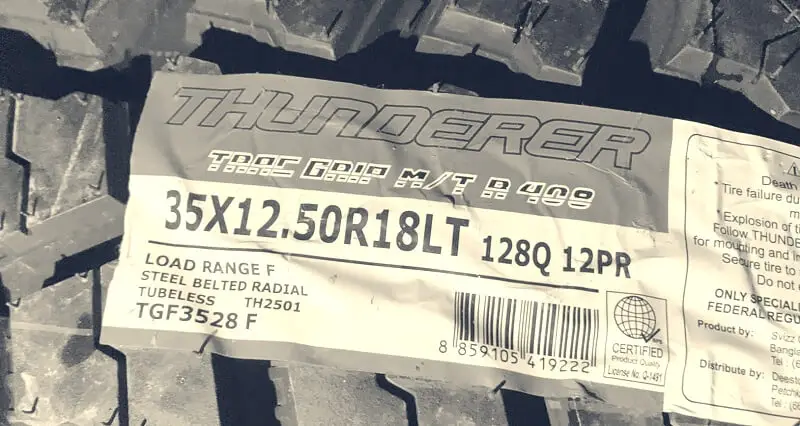Tire Size 35×12.50r18 in Metric

Have you ever wondered what the alphanumeric code “35×12.50r18” on your truck tires actually means? At first glance, these figures may seem like cryptic code, yet each number and letter holds essential information about your tire’s dimensions.
This article will walk you through the intriguing world of tire sizes, focusing on the 35×12.50r18, a common size in the off-road community.
Dimension Breakdown
Let’s start by breaking down the 35×12.50r18 tire size. The first number (35) represents the tire’s overall diameter in inches. The second number (12.50) signifies the tire width, also in inches.
The “r” stands for radial, implying the tire’s construction type. The last number (18) indicates the wheel diameter, again in inches, onto which the tire is designed to fit.
So, in simple terms, a 35×12.50r18 tire is a radial tire with an overall diameter of 35 inches, a width of 12.5 inches, and fits an 18-inch wheel.
35×12.50r18 in inches
| Feature | Metric |
|---|---|
| Tire Diameter | 35.0″ |
| Tire Section Width | 12.5″ |
| Rim Width Range | 18″ x 8.5-11″ |
| Sidewall Height | 8.5″ |
| Circumference | 109.9″ |
| Revs/Mile | 577 |
Conversion Process
To convert these dimensions into metric measurements, you must understand that one inch equals 25.4 millimeters. Therefore, using this conversion factor, we can easily convert the dimensions of 35×12.50r18 into metric units.
- Overall Diameter: The overall diameter of 35 inches translates to 889 mm.
- Tire Width: The width of 12.50 inches converts to 317.5 mm.
- Wheel Diameter: An 18-inch wheel diameter equates to 457.2 mm.
We can also calculate the Sidewall Height and the Aspect Ratio using the provided formulas.
- Sidewall Height: Using the formula (Overall Diameter – Wheel Diameter) / 2, we find the Sidewall Height to be 8.75 inches, which converts to 222.25 mm.
- Aspect Ratio: With the formula (Sidewall Height / Tire Width) * 100%, the aspect ratio computes to 70%.

Finding a Close Metric Equivalent
To find a close metric equivalent for the 35×12.50r18 tire size, you must match the tire width, aspect ratio, and wheel diameter in millimeters to the metric tire size. The closest metric equivalent would be 320/70R18.
Practical Applications
The 35×12.50r18 tire size is popular for various off-road and sport utility vehicles, including pickup trucks and large SUVs. For example, off-roaders favor these tires for their excellent ground clearance and wider contact patch, increasing traction on off-road terrains. Moreover, this tire size is standard on vehicles such as the Ford F-150 or Jeep Wrangler, known for their off-road capabilities.
What Is Equivalent To A 35×12.50r18?
The tire size commonly referred to as 35×12.50r18 can be approximately converted into the metric system as 318/68r18. It’s important to mention that this specific size isn’t commonly found in retail shops.
The metric dimension is often seen; the closest equivalent is 315/65r18. This size closely matches the characteristics of a 35×12.50r18 tire, and it’s generally more accessible for customers to purchase.
How Tall Are 35×12.50r18 Tire Size?
The ’35’ represents the tire’s overall diameter in inches. Therefore, the tire’s height from the ground to the top of the tire (when mounted on a wheel and inflated) is approximately 35 inches. In millimeters, this converts to about 889 millimeters.
How Wide Is A 35×12.50r18 Tire?
The ‘12.50’ refers to the width of the tire in inches. Therefore, a 35×12.50R18 tire is 12.50 inches wide. In millimeters, this is approximately 317.5 millimeters.
What Size Rim Fits 35×12.50r18?
The ’18’ denotes the diameter of the wheel (rim) that the tire fits onto in inches. Therefore, a 35×12.50R18 tire fits on an 18-inch rim. In millimeters, this translates to about 457.2 millimeters.
Summary
Understanding tire sizes, such as the 35×12.50r18, allows you to make informed decisions when purchasing new tires, replacing existing ones, or customizing your vehicle. It not only helps you select the correct tire size but also assists in evaluating performance characteristics, such as ride comfort, fuel efficiency, and traction.
In a world increasingly moving towards the metric system, it’s beneficial to understand how to convert these measurements and find equivalent metric tire sizes. This knowledge bridges the gap between the standard and metric systems and expands your options when shopping for tires internationally or online.
Remember, having the right tires can significantly enhance your vehicle’s performance and safety. So, invest time in understanding these alphanumeric codes – it’s more than just numbers and letters; it’s the key to your vehicle’s optimum performance.

Meet Caitlin McCormack, a Tire Size Expert and Blogger Passionate About Everything Related to Tires. With Years of Experience in the Tire Industry, Caitlin Has Become an Expert in Tire Sizes and Their Impact on Vehicle Performance.
